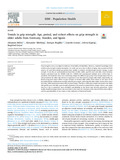Mostrar el registro sencillo del ítem
Trends in grip strength: age, period, and cohort effects on grip strength in older adults from Germany, Sweden, and Spain
| dc.creator | Beller, Johannes | es_ES |
| dc.creator | Miething, Alexander | es_ES |
| dc.creator | Regidor Poyatos, Enrique | es_ES |
| dc.creator | Lostao Unzu, Lourdes | es_ES |
| dc.creator | Epping, Jelena | es_ES |
| dc.creator | Geyer, Siegfried | es_ES |
| dc.date.accessioned | 2020-02-18T13:10:05Z | |
| dc.date.available | 2020-02-18T13:10:05Z | |
| dc.date.issued | 2019 | |
| dc.identifier.issn | 2352-8273 | |
| dc.identifier.uri | https://hdl.handle.net/2454/36278 | |
| dc.description.abstract | Grip strength is seen as an objective indicator of morbidity and disability. However, empirical knowledge about trends in grip strength remains incomplete. As trends can occur due to effects of aging, time periods and birth cohorts, we used hierarchical age-period-cohort models to estimate and disentangle putative changes in grip strength. To do this, we used population-based data of older adults, aged 50 years and older, from Germany, Sweden, and Spain from the SHARE study (N = 22500) that encompassed multiple waves of first-time respondents. We found that there were contrasting changes for different age groups: Grip strength improved over time periods for the oldest old, whereas it stagnated or even decreased in younger older adults. Importantly, we found strong birth cohort effects on grip strength: In German older adults, birth cohorts in the wake of the Second World War exhibited increasingly reduced grip strength, and in Spanish older adults, the last birth cohort born after 1960 experienced a sharp drop in grip strength. Therefore, while grip strength increased in the oldest old aged 80 years and older, grip strength stagnated or decreased in comparatively younger cohorts, who might thus be at risk to experience more morbidity and disability in the future than previous generations. Future studies should investigate factors that contribute to this trend, the robustness of the observed birth cohort effects, and the generalizability of our results to other indicators of functional health. | en |
| dc.description.sponsorship | This paper was funded by the DFG (German Research Foundation), reference number GE 1167/15-1. This paper uses data from SHARE Waves 1, 2, and 5 (DOIs: 10.6103/SHARE.w1.611, 10.6103/SHARE.w2.611, 10.6103/SHARE.w5.611), see Börsch-Supan et al. (2013) for methodological details. The SHARE data collection has been primarily funded by the European Commission through FP5 (QLK6-CT-2001-00360), FP6 (SHARE-I3: RII-CT-2006-062193, COMPARE: CIT5-CT-2005-028857, SHARELIFE: CIT4-CT-2006-028812) and FP7 (SHARE-PREP: N°211909, SHARE-LEAP: N°227822, SHARE M4: N°261982). Additional funding from the German Ministry of Education and Research, the Max Planck Society for the Advancement of Science, the U.S. National Institute on Aging (U01_AG09740-13S2, P01_AG005842, P01_AG08291, P30_AG12815, R21_AG025169, Y1-AG-4553-01, IAG_BSR06-11, OGHA_04-064, HHSN271201300071C) and from various national funding sources is gratefully acknowledged (see www.shareproject.org ). | en |
| dc.format.extent | 9 p. | |
| dc.format.mimetype | application/pdf | en |
| dc.language.iso | eng | en |
| dc.publisher | Elsevier | en |
| dc.relation.ispartof | SSM - Population Health, 2019, 9, 100456 | en |
| dc.rights | © 2019 The Authors. Published by Elsevier Ltd. This is an open access article under the CC BY-NC-ND license. | en |
| dc.rights.uri | http://creativecommons.org/licenses/by-nc-nd/4.0/ | |
| dc.subject | Grip strength | en |
| dc.subject | Morbidity | en |
| dc.subject | Trend | en |
| dc.subject | Compression | en |
| dc.subject | Expansion | en |
| dc.title | Trends in grip strength: age, period, and cohort effects on grip strength in older adults from Germany, Sweden, and Spain | en |
| dc.type | info:eu-repo/semantics/article | en |
| dc.type | Artículo / Artikulua | es |
| dc.contributor.department | Sociología y Trabajo Social | es_ES |
| dc.contributor.department | Soziologia eta Gizarte Lana | eu |
| dc.rights.accessRights | info:eu-repo/semantics/openAccess | en |
| dc.rights.accessRights | Acceso abierto / Sarbide irekia | es |
| dc.identifier.doi | 10.1016/j.ssmph.2019.100456 | |
| dc.relation.publisherversion | https://doi.org/10.1016/j.ssmph.2019.100456 | |
| dc.type.version | Versión publicada / Argitaratu den bertsioa | es |
| dc.type.version | info:eu-repo/semantics/publishedVersion | en |



